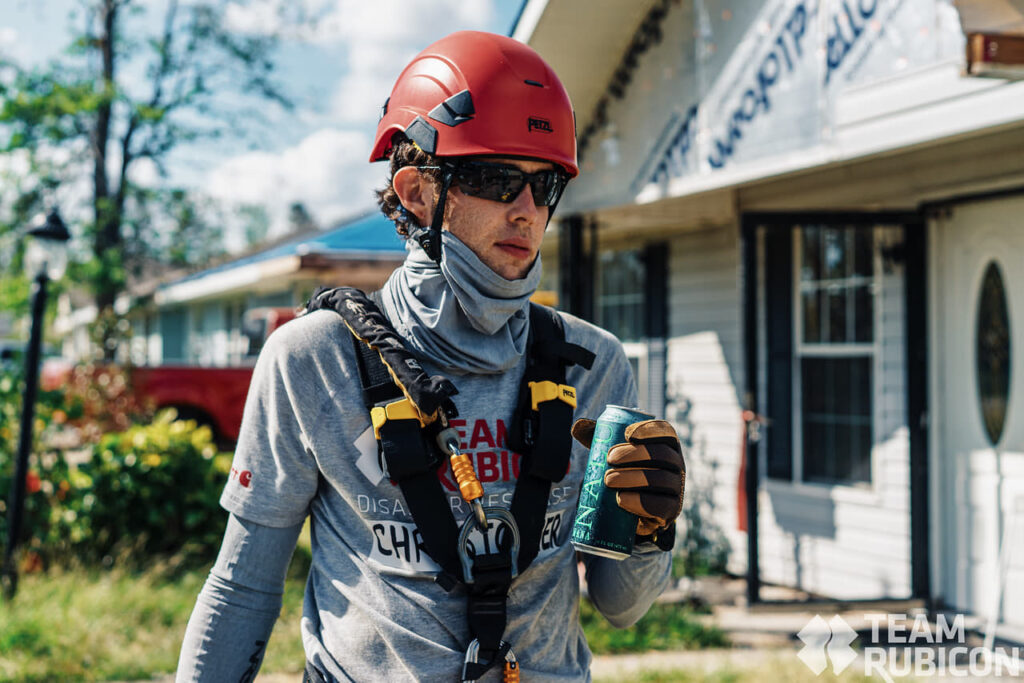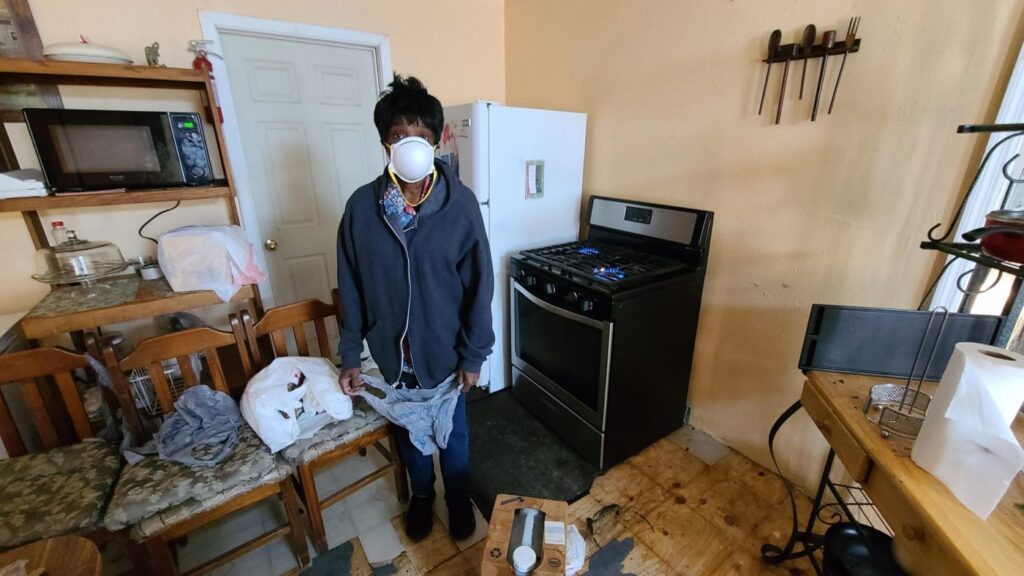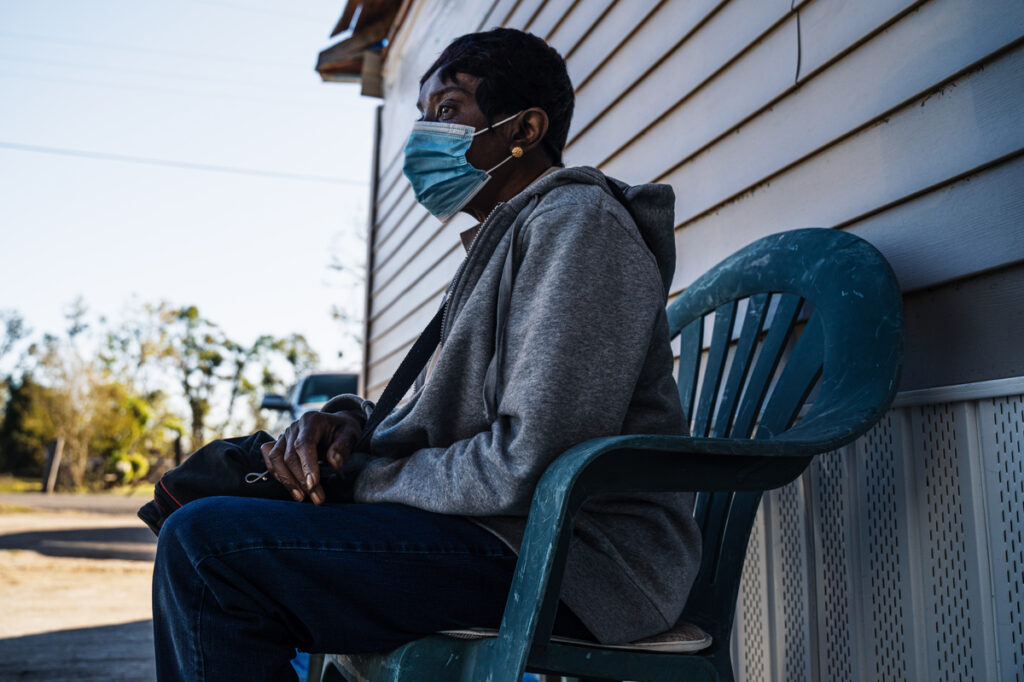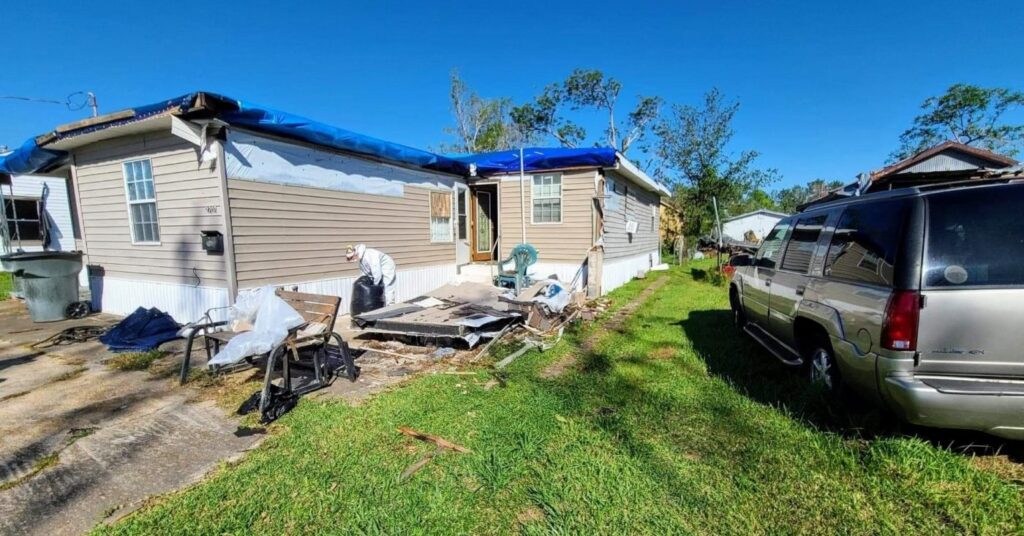It was October 30, 2020, and I had been on the ground in Lake Charles, LA, for a couple of weeks. I had initially deployed to Lake Charles with Team Rubicon in early September, after Hurricane Laura, to help stand up our tarping program. I’d returned in mid-October after Hurricane Delta hit. By this point, I was filling the role of Technical Specialist in the field as well as instructing Greyshirts who were interested in completing our new roof tarping training.
Right around 9 a.m. I got a call from a Team Rubicon strike team leader, Hannah, who had just finished up a muck-out job and been dispatched to a work order that needed both a muck out and the roof tarped. This home had already been tarped once, after Hurricane Laura, but Hurricane Delta had come and gone since. Hannah asked if I would meet her strike team at their next job to figure out what needed to be done.
Part of my role for the previous two weeks had been vetting all of the jobs that had been completed by Greyshirts a few weeks prior. Hurricane Laura had caused massive amounts of roof damage in Lake Charles, and Team Rubicon Greyshirts had tarped roofs for six weeks after. Unfortunately, only about 15% of those tarps had withstood the beating brought on by Hurricane Delta. Now, we were cleaning up after that storm too, and redoing work that hadn’t stood the second hurricane.
I arrived at Church Street, on the east side of Lake Charles, just after 9 a.m. looking to make contact with the homeowner, Susan. Unfortunately, we did not have a phone number for her, so I was hoping someone would be home so I could assess what all needed to be done, and so we could start work.

The neighborhood had been hit hard. Roofs were blown off and some houses had been abandoned. Susan’s house had been damaged badly, too. The carport garage had been blown off. The roof was missing nearly all its shingles and the tarps that still held on were flapping in the wind. The siding had been ripped off the house and, from the outside, I could see up into the attic space in some places. In my head, I could tell there was a lot of work to be done.
Not long after I arrived, Susan got dropped off by a friend. I introduced myself and explained that I was one of the Team Rubicon Greyshirts and that I was here to help the team get started. Susan was very glad to have someone willing to help her. Even then, I could sense that she was very worn out. She also seemed confused about what needed to be done to her home. I was making it a point to help dispel that confusion.
It was cold for Louisiana that morning—a brisk 44 degrees with 15-20 mph winds—and as we talked Susan unlocked the door and invited me inside. Little did I know, as I walked across the threshold of that door, my life would be forever changed.
Susan’s first move was to turn on her gas stove to cut back the chill inside the hurricane-damaged home. Like so many in this area, water had infiltrated the walls after the hurricanes and some areas were starting to mold. As she began to warm up, I asked permission to look around. Susan told me to make myself at home and to look at whatever I needed.

There was a considerable amount of water damage and contamination inside her home, enough that all the ceilings, walls, and carpet in the house would need to be mucked out. After a thorough inspection of each room, the attic, and the roof, I went back into the kitchen and took a moment to warm my hands next to Susan. Both of us were wearing N95 masks at this point, not only because of the COVID-19 pandemic but also because of the amount of contamination inside the home. Standing by the stove, I explained that we would have to retarp the entire roof, and also that her home would need to be completely gutted. Gutting—or mucking out—is something Team Rubicon does with a well-driven passion. While we don’t typically rebuild homes—outside of our Rebuild programs—by taking out soaked drywall and pulling out contaminated carpet and ruined furniture at no cost to the homeowner, we help prevent more contamination and make it possible for the homeowner to repair the home, safely.
At this point, Susan began to cry. I assumed that she was crying because her house had been destroyed and I attempted to provide some comfort. We at Team Rubicon would do all the work for her, I explained, at no cost to her. All she would have to do is point out what items she wanted to keep and we would carefully separate everything.
As it turned out, Susan wasn’t crying because her roof was damaged or the walls needed replacing. Rather, the hurricane damage was just icing on a bitter cake. This woman, who had survived multiple hurricanes, made an effort to choke back her tears and began to tell me a story about her son—a young man who, I would later learn, was born just one week before I was.
On November 2, 2019 a young man showed up at Susan’s house and began shooting. In all, the shooter fired 11 times; five of those bullets hit Susan’s 27-year-old son, Quentin. He took his last breaths sitting on a bench in the front driveway—a bench Susan has decided to keep.

As we stood by the stove Susan took a breath, raised a hand, and pointed to the exterior wall behind me. I turned around to see three bullet holes in kitchen cabinets and a couple more scattered in the wall. Every time Susan stood in that kitchen, she had to look at those bullet holes.
Those holes… They had been haunting her for 363 days. It was Friday, October 30, 2020. Quentin had been killed nearly a year to the day of our meeting. By this point, I disregarded social distancing. Susan needed a hug, and so did I. Besides, Greyshirts are known for giving the best hugs.
“You know,” Susan told me, “I think that God did all of this destruction so that my home could be made new.”
This statement floored me. Here was a woman grieving her son lost to a senseless and violent murder, in a home nearly destroyed from not one hurricane but two, and she still held onto her faith with such grace.
At that moment, my life changed forever.
It’s the Team Rubicon ethos that we try to provide hope on people’s darkest days, to give them some sense of normalcy. With Susan, it was twofold. I was there to serve her, as were the two strike teams, but in a sense, it was like she was serving me in telling me her story. She’d gone through multifaceted disasters—brain surgery earlier in life, losing her son, multiple hurricanes, and living in the hurricane-struck home where her son had died—yet through it all she was finding a way to keep her perspective positive. She was finding blessings happening in the middle of the tragedy.
I gained so much speaking to Susan in that 15-minute window. This moment shifted my paradigm in such a way I will never be the same person. If Susan could go through all of this, still keep her chin up, and continue fighting the good fight then I could too. The bad days, don’t seem so bad with a friend.

Hannah and the strike team started working on Susan’s home that day, removing items that couldn’t be salvaged and even pulling out two rooms worth of carpet. On November 2, 2020, the first anniversary of Quentin’s death, our team began gutting the home and tarping the roof. It was a tough day, but we all got through it together.
Since leaving Operation Crying Eagle, I have stayed in close contact with Susan. We will be friends for the rest of our lives. Recently, I learned she had been approved by our Lake Charles Rebuild program, and her home is in the process of being completely rebuilt. (Thank you Team Rubicon!)
Team Rubicon provides something to this world that is truly something special. But, as much as Team Rubicon may be helping Susan now, Susan gave me something that money cannot buy, something that cannot be found on a store shelf. She gave me the gift of hope and friendship.




